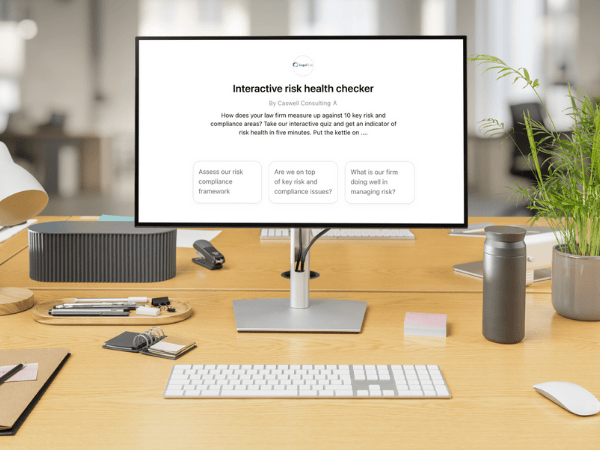The Solicitors Regulation Authority (SRA) has been clear. When it comes to AML: “Training is an excellent indicator of compliance.” But what does good training look like, and how can firms meet regulatory expectations while delivering real value?
The SRA’s recent update stresses that AML training should be:
- Accessible and relevant to all staff members
- Grounded in real-life examples to make the training relatable and current
- Delivered using a variety of methods
- Tested to ensure effectiveness in the real world.
Here we explore what makes AML training effective based on the latest advice from the SRA’s recent AML and Financial Crime conference.
-
Accessible and relevant AML training
AML training must not be exclusive to senior staff or specific teams, such as conveyancers or the Money Laundering Reporting Officer (MLRO). Every employee in the firm, from paralegals to partners, must receive training relevant to their role. For instance, while an MLRO may need in-depth knowledge of risk assessments, front-line staff require practical guidance on identifying and escalating suspicious activity. Tailoring training content ensures everyone understands their responsibilities and is empowered to act effectively.
-
Use of real-life examples and case studies
Good AML training goes beyond theoretical explanations of the regulations. The SRA encourages using real-life examples from within the firm, such as internal Suspicious Activity Reports (SARs), audits (like those carried out under Regulation 21), and recent news stories about AML failures in the legal sector.
By incorporating these examples, staff can see how the principles apply in practice. It makes the content more engaging and demonstrates the direct impact of AML compliance (or lack thereof) on both the firm and its clients.
-
Variety in delivery methods
The SRA highlights the importance of using various methods to engage staff and ensure knowledge retention. This might include:
- Workshops and interactive sessions where staff can discuss scenarios and learn from each other
- E-learning modules that offer flexibility but are updated regularly with new content and developments in AML regulations
- Quizzes and assessments to test understanding and identify areas where further training may be needed
- Live webinars and case study discussions to allow for interactive learning and Q&A sessions with compliance experts.
Mixing digital and in-person training sessions will cater to your team’s different learning styles and needs. But remember to ensure online resources are updated regularly to prevent reliance on outdated information.
-
Testing the effectiveness of AML training
The SRA recommends firms measure the effectiveness of their AML training programs by regularly testing whether policies are being correctly applied to client files. This can be done through internal audits, spot checks, or file reviews.
Regular testing and monitoring can help identify gaps in knowledge or application, allowing firms to provide additional support where necessary. For instance, if a file review reveals staff are not consistently verifying client identities according to AML requirements, the firm can conduct refresher sessions focusing on this area.
What does bad AML training look like?
Understanding what effective AML training entails is just as important as understanding what ineffective training looks like. The SRA identifies several common pitfalls that law firms must avoid
- Generic or irrelevant training: Training designed for another sector (eg banking) or that only covers broad AML principles without specific application to a law firm’s operations is unlikely to be effective.
- Limited training for specific staff: Restricting AML training to senior personnel or specific teams leaves other staff unaware of their responsibilities and exposes the firm to compliance breaches.
- One-time training sessions: AML training should not be a one-time exercise, such as during recruitment. Ongoing training is necessary to keep staff up-to-date with the latest regulatory changes and expectations.
- High-level content with no practical application: Training that only discusses AML principles and offences, without practical, role-based guidance, is unlikely to be effective in day-to-day operations.
- Stale e-learning modules: Using the same e-learning content year after year without updates can result in staff becoming disengaged and unaware of recent regulatory developments.
- “Read the policy” approach: Asking staff to read the firm’s AML policy without interactive elements or practical training is insufficient to build understanding or engagement.
Building a robust AML training program
To avoid these pitfalls and build a robust AML culture, firms should regularly update training content to reflect regulatory changes, with recent examples of AML breaches within the industry. Firms should also encourage ongoing education by incorporating AML topics into team meetings, providing access to updated resources, and encouraging staff to stay informed about AML trends.
Engaging external compliance experts to provide up-to-date insights and a fresh perspective helps ensure training is current, relevant, and delivered in a manner that will engage. At Legal Eye, we offer a wide range of AML training solutions designed specifically for law firms. With a blend of digital learning and practical, scenario-based sessions – including enhanced masterclasses for AML professionals – we keep your firm compliant and secure.
Contact us to learn more about our AML training programs today. Call us today on 020 3051 2049 or email [email protected] to find out how we can help.
 (0)20 3051 2049
(0)20 3051 2049




